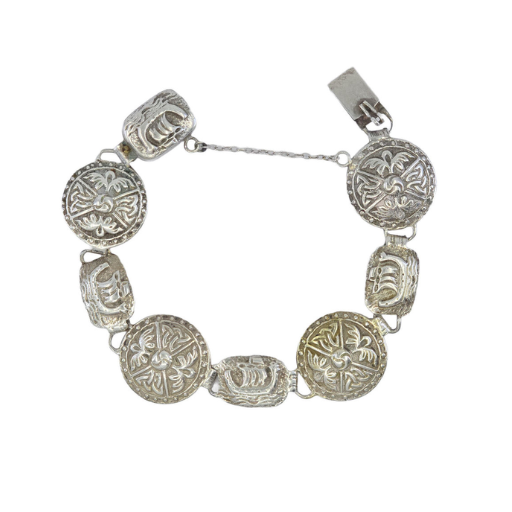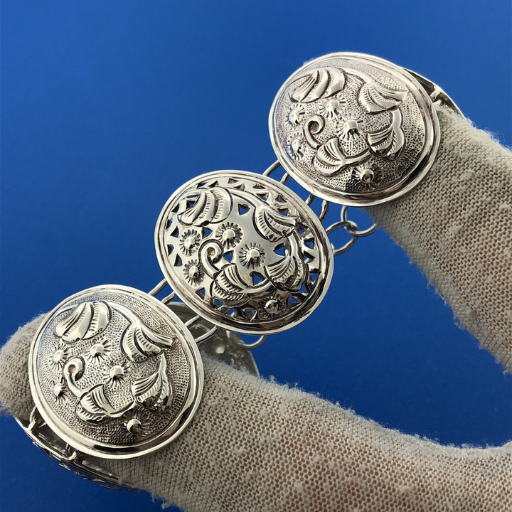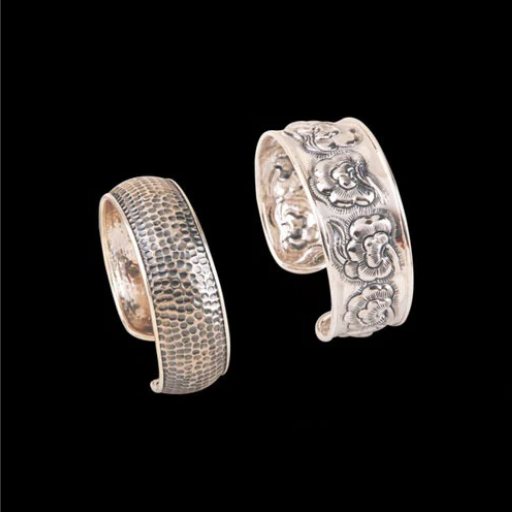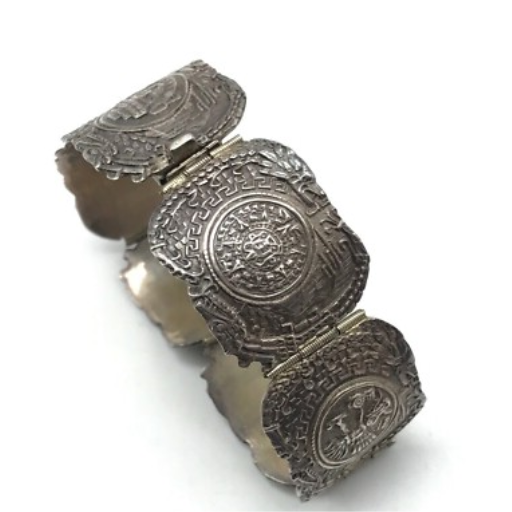Stainless steel and sterling silver are usually the most wanted options for metal types regarding jewelry, daily accessories, or household items. The two options are widely sought after because of their durability, aesthetic appeal, and versatility. However, each comes with unique features that set them apart. Would you prefer something sleek and easy to maintain, or something that exudes timeless elegance, charm, and tradition? This blog post sheds light on the most fundamental differences between stainless steel and sterling silver, specifically their composition, appearance, and maintenance, among other factors. By the end of the post, readers will feel confident making an informed decision suited to their needs and personal preferences.
What Are the Key Differences Between Stainless Steel and Sterling Silver?

Stainless steel and sterling silver differ in several key aspects:
- Composition: The constituents of stainless steel include an alloy consisting primarily of iron and chromium alongside some other metals, making it durable as well as corrosion-resistant. Sterling silver is an alloy composed of 92.5% silver and 7.5 % of other metals, usually copper, which enhances the strength of the silver.
- Appearance: Sterling silver has a traditional classic, bright, and polished look while carrying a timeless fine touch, while stainless steel has a sleeker, more modern aesthetic.
- Durability: Sterling silver is softer and more prone to tarnishing over time, making it more delicate to handle than stainless steel, which can withstand scratches, tarnish, and damage.
- Care Requirements: Known for its low maintenance, stainless steel is easy to clean compared to sterling silver, which requires polishing regularly to uphold its shine.
Thus, distinguishing appeal most bestows stainless steel for practicality and timeless silver for elegance and tradition.
Understanding Alloy Composition in Detail
Alloys are more than just a blend of metals; they are composite materials created by adding one or more metallic elements to increase certain characteristics like strength, durability, or even corrosion resistance. Some triumph alloy inventions are stainless steel, sterling silver, brass, and bronze.
- Stainless Steel Composition
Stainless steel is an alloy that comprises iron and contains at least 10.5% chromium, providing corrosion resistance. Nickel and molybdenum are also added, as they provide strength and further improve performance under hostile conditions. Recent studies reveal that 304 stainless steel, one of the most popular grades, contains approximately 18 to 20% chromium and 8 to 10.5% nickel.
- Sterling Silver Composition
Sterling silver contains silver, which makes up 92.5% of the alloy. 7.5% of this is usually copper or other metals added to strengthen the structure and prevent it from being soft. Copper is the common secondary element, although more recent alloys sometimes add small quantities of silicon or zinc to enhance anti-tarnish properties. These blends are uncommon.
- Brass and Bronze Comparisons
Brass, used in many industries, is a copper-zinc alloy whose components can be altered to fine-tune desirable qualities such as flexibility or hardness. Cartridge brass, for instance, is 70% copper and 30% zinc. Bronze is mostly copper with around 12-15% tin added, imparting improved resistance to corrosion, especially in seawater.
- Emerging Trends and Innovations in Alloys
Current alloys research concentrates on developing superalloys for aerospace applications, among other specific high-performance alloys. These superalloys include nickel, cobalt, and titanium, designed to endure high-temperature and high-stress conditions. INCONEL alloys, for example, are widely known for their use in jet engines due to their outstanding oxidation and thermal degradation resistance.
Knowledge of the alloy composition enables industries to identify the optimal material for a specific process with the best economic, strength, and durability aspects. Innovations in these materials technologies make alloys even more tailored for contemporary engineering and ecological requirements.
Why Stainless Steel Offers More Durability
Stainless steel is one of the most durable materials available and is used in many different applications because of its unique properties. Below are five reasons why stainless steel is one of the most durable steels:
- Corrosion Resistance
Stainless steel has chromium, and when it is oxidized, it creates a passive layer of chromium oxide. This layer protects stainless steel from rusting and corrosion, making it favorable for marine applications, chemical processing, and outdoor constructions.
- High Tensile Strength
The combination of elements that make up stainless steel, such as nickel and molybdenum, contributes to its astonishing tensile strength. This allows it to carry heavy stress loads without undergoing deformation, which is necessary in construction and industrial machines.
- Temperature Resistance
Stainless steel can withstand very high and very low temperatures. For example, high-temperature grades like 310 and 316 stainless steel can resist scaling and keep their strength above 1000°F (538°C).
- Little Required Upkeep
Compared with other materials, stainless steel tools and structures require minimal upkeep. The smooth surface, stain, and corrosion resistance of stainless steel increase service life while reducing maintenance costs.
- Eco-Friendly Properties
Stainless steel is 100% recyclable, making it an environmentally friendly choice. Its extended service life reduces the need for replacements, minimizing resource consumption and materials waste.
Collectively, these factors guarantee that engineers, architects, and manufacturers looking for durable and dependable materials will continue to favor stainless steel.
How Sterling Silver May Tarnish Over Time
Like most other silver items, sterling silver can tarnish due to exposure to sulfur-containing substances in the atmosphere, humidity, and other environmental pollutants. Because the copper alloy in sterling silver reacts with these elements, I have observed that tarnish forms on the surface as a darkened layer over time. Storing sterling silver jewelry away from moisture and placing it into a sealed, dry container helps slow tarnishing, keeping it looking its best. Regular cleaning also helps.
How Is Each Material Used in Jewelry?

Items such as rings, necklaces, and bracelets all feature silver due to its low cost and shine. Gold is commonly used in fine jewelry like wedding bands and elaborate pendants because of its longevity and polished finish. Platinum is highly valued for engagement rings and other luxury items due to its resistance to tarnishing and excellent strength. Gemstones such as diamonds and sapphires are put in jewelry to enhance color and sparkle, often becoming the centerpiece of many designs. These materials have surprisingly different properties, giving designers countless options to build stunning yet functional jewelry.
The Popularity of Stainless Steel Jewelry
Due to its low cost, strength, and sleek look, stainless steel jewelry has become very popular, with Google searches showing a steady increase over the past few years.
Why Sterling Silver Jewelry is a Classic Choice
| Key Point | Description |
|---|---|
| Timeless Elegance | It never goes out of style and suits all occasions. |
| Affordability | Luxurious look at a fraction of gold’s cost. |
| Durability | Strong alloy resists damage with care. |
| Versatility | Complements casual and formal outfits. |
| Hypoallergenic | Safe for sensitive skin, minimal irritation. |
| Easy Maintenance | Simple cleaning keeps it shiny and new. |
| Rich History | Treasured across cultures and eras. |
| Perfect for Gifting | Thoughtful, meaningful, and long-lasting. |
| Adaptable Designs | Malleable for intricate or modern styles. |
| Heirloom Potential | It can be passed down through generations. |
How Does Silver vs Stainless Steel Jewelry Maintenance Differ?

The need for maintenance differs with the type of jewelry. Due to the ability of sterling silver jewelry to tarnish with time due to air exposure, maintenance is more frequent cleanings with polishing cloths or silver cleaners. Because stainless steel is more resistant to tarnishing and corrosion, it requires much less maintenance and is easier to care for. Stainless steel requires washing with soap, water, and a polishing cloth. Although both materials are durable, stainless steel surpasses silver in maintenance, making it ideal for daily wear.
Keeping Your Stainless Steel Jewelry Shiny
| Key Point | Description |
|---|---|
| Regular Cleaning | Use mild soap and water to clean regularly. |
| Avoid Harsh Chemicals | Keep away from bleach, chlorine, and ammonia. |
| Use Soft Cloths | Polish with soft, non-abrasive cloths. |
| Toothpaste Cleaning | Use non-gel toothpaste for gentle scrubbing. |
| Baking Soda Paste | Mix baking soda and water for tough stains. |
| Proper Storage | Store in soft pouches or lined boxes. |
| Avoid Prolonged Water | Remove before swimming or showering. |
| Polish Occasionally | Use polishing cloths to restore shine. |
| Remove Before Activities | Avoid wearing during sports or heavy tasks. |
| Dry Thoroughly | Prevent water spots by drying immediately. |
Maintaining the Luster of Silver Jewelry Pieces
| Key Point | Description |
|---|---|
| Avoid Humidity | Store in sealed bags to prevent tarnish. |
| Steer Clear of Chemicals | Avoid contact with perfumes, bleach, etc. |
| Regular Cleaning | Use silver polish or polishing cloths. |
| Proper Storage | Use anti-tarnish strips or airtight boxes. |
| Avoid Prolonged Sunlight | Store in cool, shaded areas. |
| Wear Often | Natural oils can help prevent tarnish. |
| Use Baking Soda Paste | Gently scrub tarnish with baking soda paste. |
| Professional Maintenance | Seek expert care for intricate designs. |
| Dry Thoroughly | Prevent water spots by drying immediately. |
| Use Anti-Tarnish Strips | Absorb tarnish-causing elements in storage. |
Which is a Better Choice for Sensitive Skin: Sterling Silver vs Stainless Steel?

Sterling silver contains small amounts of nickel and other additives, which may lead to allergic reactions in sensitive individuals. Because of these additives, sterling silver is not a good jewelry option for allergy sufferers. On the other hand, stainless steel contains no allergens, making it more appealing. For people with sensitive skin, stainless steel is a safer option to wear regularly.
Allergies and Sensitivities to Steel Ring Materials
Even though stainless steel is generally considered hypoallergenic, there are still possible sensitivities and allergens to steel rings that need to be understood. The following are five known allergy and sensitivity culprits associated with steel ring materials:
- Nickel Content
Nickel may be present in some stainless steel alloys, especially of lower grade. Nickel is an allergen to a subset of people and is known to affect about 10-20% of the population. After prolonged exposure, it can cause contact dermatitis, redness, swelling, and itching.
- Chromium Sensitivity
Chromium improves stainless steel’s corrosion resistance. Rarely, people become sensitive to chromium and, with prolonged exposure, might experience rashes or irritation.
- Cobalt Trace Elements
Steel alloys may contain minute traces of cobalt. Even minute amounts can lead to skin irritation and, consequently, a cycle of discomfort and itching for those allergic to cobalt.
- Surface Coatings or Finishes
Some rings with embellishing coatings, such as platters or paint, may contain a substance with allergenic properties. An example is plating that contains residues of chemicals or alloys that can cause skin irritation to people with sensitive skin.
- Improperly Manufactured Alloys
Allergic reactions can occur from improperly manufactured alloys. People with allergic reactions can arise from poorly fabricated specimens containing unintentional alloys comprising non-standard metals, which result in unplanned impurities.
Awareness of these possible allergies aids in determining which type of steel to use for allergy-prone individuals. In most cases, polished stainless steel free of contaminants is acceptable. Nevertheless, checking certifications and selecting surgical stainless steel further mitigates the risks.
Benefits of Sterling Silver’s Malleability
| Key Point | Description |
|---|---|
| Intricate Designs | Enables detailed and complex jewelry patterns. |
| Versatile Applications | Suitable for various decorative items. |
| Custom Creations | Ideal for personalized and unique pieces. |
| Gemstone Compatibility | Pairs well with diverse gemstones. |
| Wide Range of Textures | Allows crafting of smooth or textured finishes. |
| Adaptable Styles | Fits minimalist to bold statement designs. |
| Durable Yet Flexible | Strong alloy that retains shape under crafting. |
| Affordable Luxury | Offers premium designs at a lower cost. |
Why Choose Sterling Silver and Stainless Steel for Your Jewelry Collection?

Sterling silver and stainless steel choices work flawlessly with any jewelry collection because of their cost-effectiveness, durability, and adaptability. Elaborate and unique pieces can be created with sterling silver since it can be shaped into almost any form, has a timeless, stunning appearance, and provides elegance. Stainless steel’s unparalleled resistance to tarnish, corrosion, and daily use allows for a lasting quality. Both metals are hypoallergenic when well-cared for, making them safe for sensitive skin. The two, together, form a mixture of beauty, strength, and practicality that matches numerous preferences and styles.
Balancing Silver’s Beauty with Stainless Steel’s Strength
Blending timeless silver elegance with stronger stainless steel creates a practical balance in contemporary jewelry. Silver has been employed extensively in decorative arts and fashion for centuries due to its malleability and lustrous sheen. Meanwhile, stainless steel showcases contemporary practicality, being robust, rust-resistant, and tarnish-free.
The shift in customer preferences has recently sparked an apparent demand for mixed-metalworks where silver and stainless steel exist side-by-side. A 2023 report from Fashion Accessories Insights also states that the global jewelry market containing about stainless steel would grow at an annual rate of 6.3%, partly owing to the material’s lower value relative to gold or platinum. In contrast, silver jewelry retains its dominion in the luxury market, expected to reach a market value of $4.56 billion by 2026.
These materials excel at creating fashion pieces that can withstand everyday use. For example, silver jewelry can exhibit intricate details and shine, but stainless steel gives it the backbone and structure to last. Such preferences appeal to those looking to maximize value, function, and beauty while aligning with new spending habits that seek sustainable fashion investments.
Combining Silver Pieces with Stainless Steel for Versatility
The combination of silver and stainless steel two-layer alloys is a jewelry form that enhances the aesthetic and practical needs of jewelry designers. This blend makes some additions to silver designs more appealing and wearable for different occasions.
Here are five main points regarding the advantages and features of combining dexterous designs with silver guns:
- Resistance and Durability Apart From Wearing Out Slowly.
Silver is also very strong, prone to wear out slowly, and requires little maintenance in the first world. Therefore, combining them bestows a harness-worthy silver elegance for years to come.
- Maintanance
As an alloy, silver requires semiannual polishing and retains its aesthetic appeal. Therefore, it requires maintenance without additional effort.
- Reachable Price
Silver remains cheaper along Ruger arms, retaining the quality best made with silver. This forms sleek lines that appeal to many jewelry lovers, especially females who consider class as style.
- Universal
Stainless steel’s texture formation complements silver’s ability to be shaped creatively, be it engravings, embossing, etching, or tegnogi patterned. Unlike silver, stainless steel enhances class and is easily fitted for both formal and informal functions.
- Hypoallergenic Properties
Both stainless steel and silver are often made to be hypoallergenic, which is ideal for sensitive skin, as it is both comfortable and fashionable.
Combining different metals into one piece for practicality, price, and resistance to trends has made modern jewelry increasingly popular.
References
- Dartmouth Toxic Metals Superfund Research Program
The Facts on Silver
This source provides detailed information about sterling silver, its composition, and uses. - University of Texas at Austin – Department of Geological Sciences
METALS main
This page discusses the properties of sterling silver and other metals, including comparisons. - Academia.edu
Comparison of The Using of Silver and Stainless Steel 316 Tubes
This academic paper explores the properties and applications of silver and stainless steel in specific contexts.
Frequently Asked Questions (FAQ)
Q: What are the main differences between stainless steel and sterling silver?
A: The main differences between stainless steel and sterling silver include their composition and properties. Stainless steel is an alloy made primarily from iron, carbon, and chromium, which makes it highly durable and resistant to rust and tarnish. Sterling silver, on the other hand, is an alloy consisting of 92.5% pure silver and 7.5% other metals, usually copper. Silver is a precious metal known for its shiny appearance, but it is softer and more prone to tarnish compared to stainless steel.
Q: Why is stainless steel a popular choice for jewelry?
A: Stainless steel is a popular choice for jewelry because it is durable, resistant to rust and tarnish, and relatively inexpensive compared to sterling silver. Its strength and resistance to scratches make it ideal for everyday wear jewelry. It is also hypoallergenic, making it suitable for sensitive skin.
Q: How does sterling silver compare to stainless steel in terms of durability?
A: Sterling silver is less durable than stainless steel. While sterling silver has a timeless charm and is used for fine jewelry, it is softer and more prone to scratches and tarnishing. Stainless steel, with its chromium content, is more robust and resistant to wear, making it better suited for pieces that undergo daily use.
Q: What grades of stainless steel are used for jewelry?
A: The most common grades of stainless steel used for jewelry include 304 and 316L. Grade 304 is known for its excellent corrosion resistance and affordability. Grade 316L is widely used for its superior durability and resistance to tarnish, making it a preferred option for those looking to get a stainless steel piece that will last.
Q: Is sterling silver more expensive than stainless steel?
A: Yes, sterling silver is generally more expensive than stainless steel. Silver is a precious metal, and the higher cost reflects its value and the craftsmanship involved in making jewelry from sterling silver. However, their beauty and timeless appeal often justify the investment in sterling silver pieces.
Q: Can I wear a sterling silver ring every day?
A: While you can wear a sterling silver ring daily, it’s important to note that silver is soft and may scratch or tarnish over time. Regular cleaning and proper storage can help maintain its shiny silver appearance. If you prefer low-maintenance jewelry, you might opt for stainless steel instead.
Q: What makes sterling silver an alloy?
A: Sterling silver is an alloy of silver combined with other metals, typically copper. The standard composition is 92.5% pure silver, 925, and 7.5% other metals. This combination enhances its durability while retaining silver’s desirable properties.
Q: Why might someone choose stainless steel over sterling silver?
A: Someone might opt for stainless steel over sterling silver due to its durability, resistance to tarnish, and lower cost. Stainless steel requires less maintenance and is ideal for individuals who lead active lifestyles or want jewelry that can withstand daily wear and tear without losing its appearance.
Q: What is the significance of chromium in stainless steel?
A: Chromium is a crucial element in stainless steel, enhancing corrosion resistance and durability. The presence of chromium forms a protective layer on the steel surface, preventing rust and tarnish, making it an excellent material for jewelry that remains shiny and attractive over time.
Q: Is it better to choose fine jewelry made of silver or steel pieces?
A: The choice between sterling silver fine jewelry and steel pieces depends on personal preferences and lifestyle. Sterling silver offers a classic and elegant appeal, ideal for those who appreciate the timeless charm of sterling silver. Steel pieces, however, provide practicality, durability, and a modern aesthetic, suitable for everyday wear and active lifestyles.







